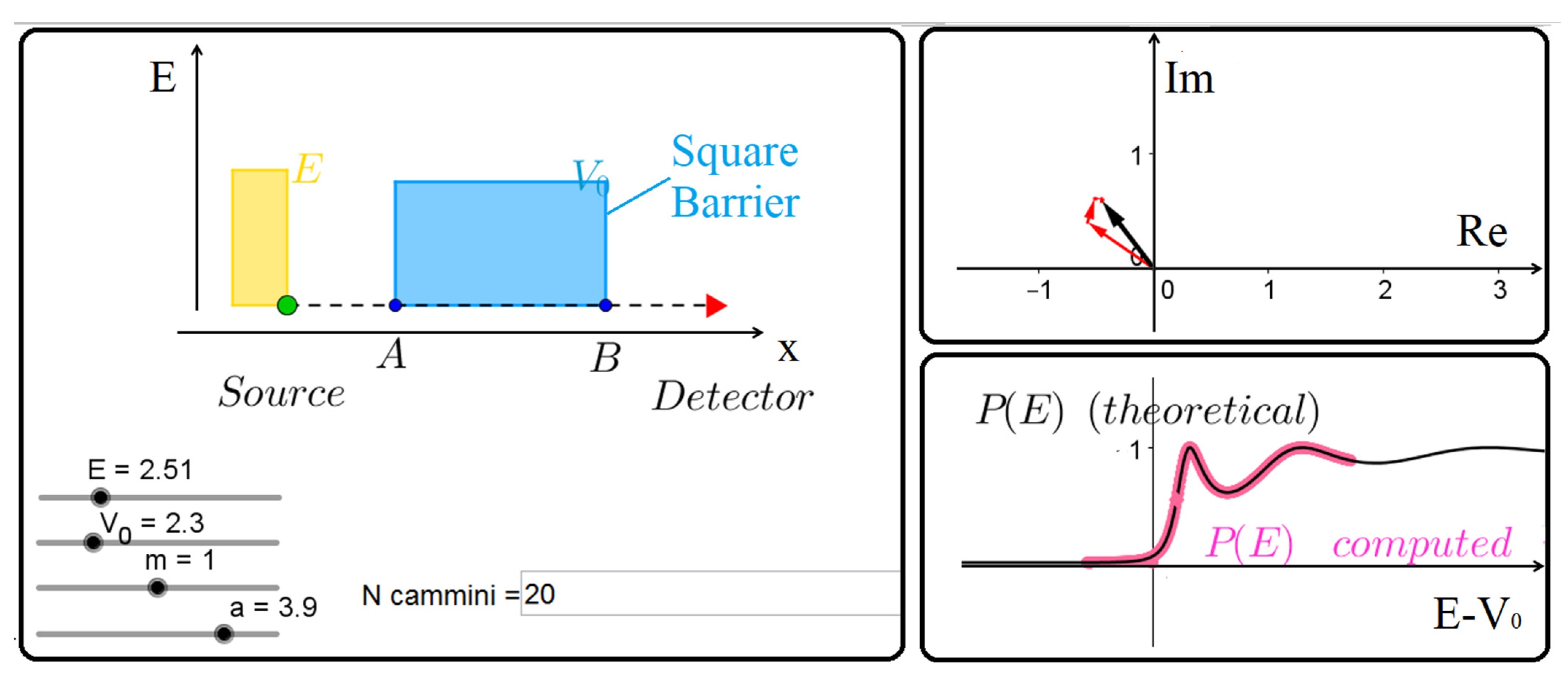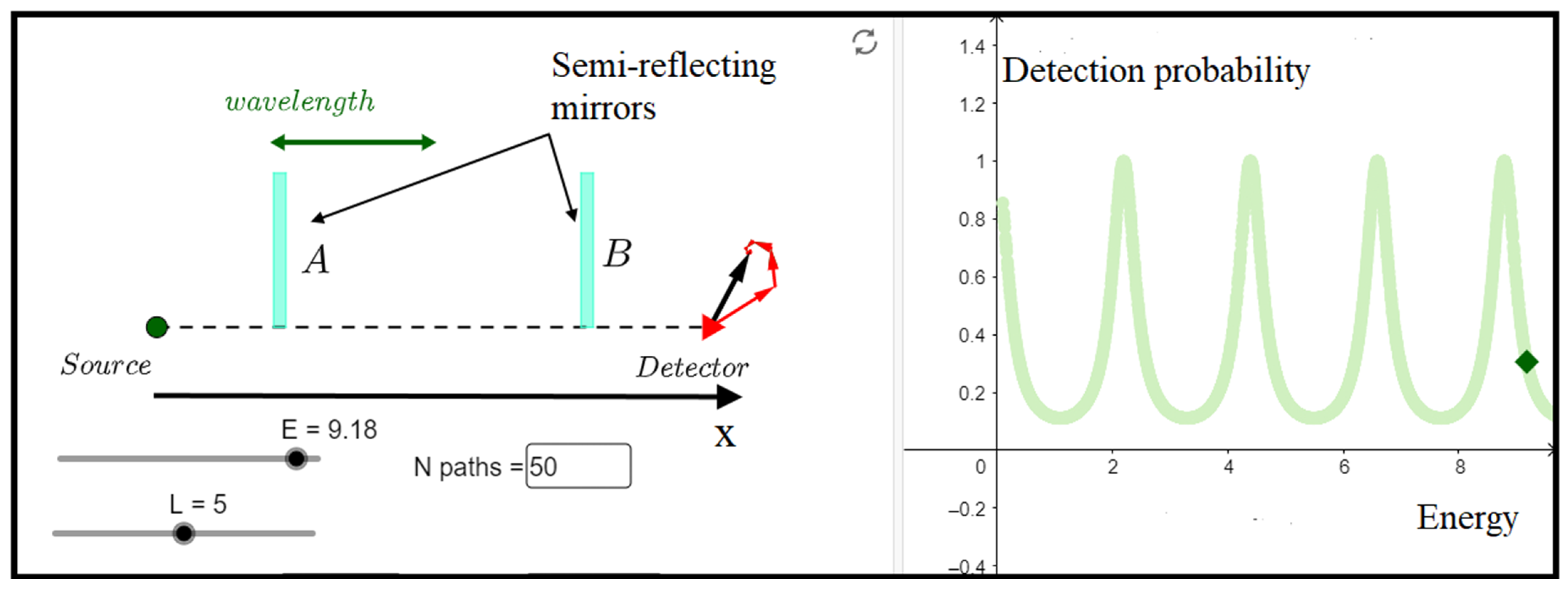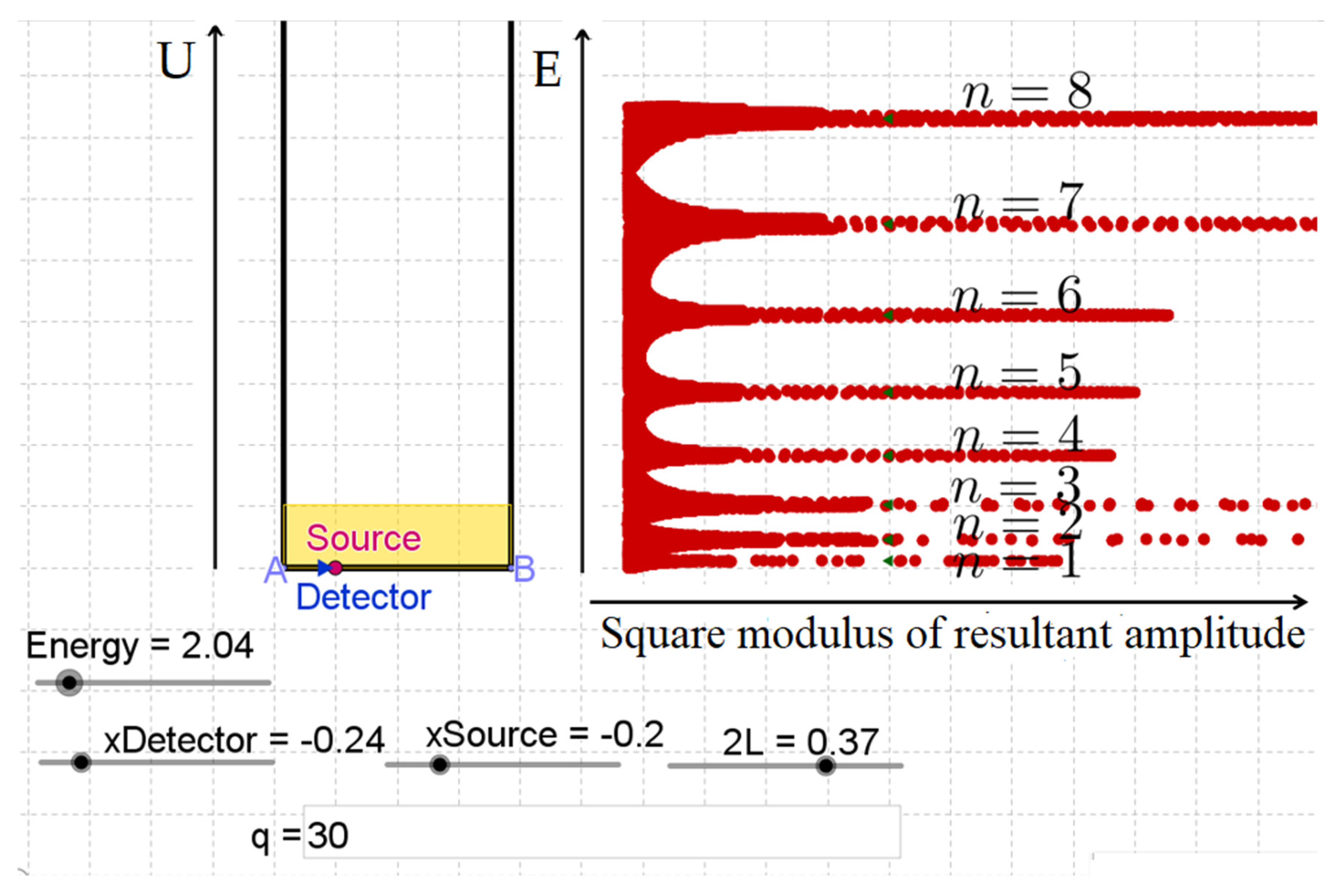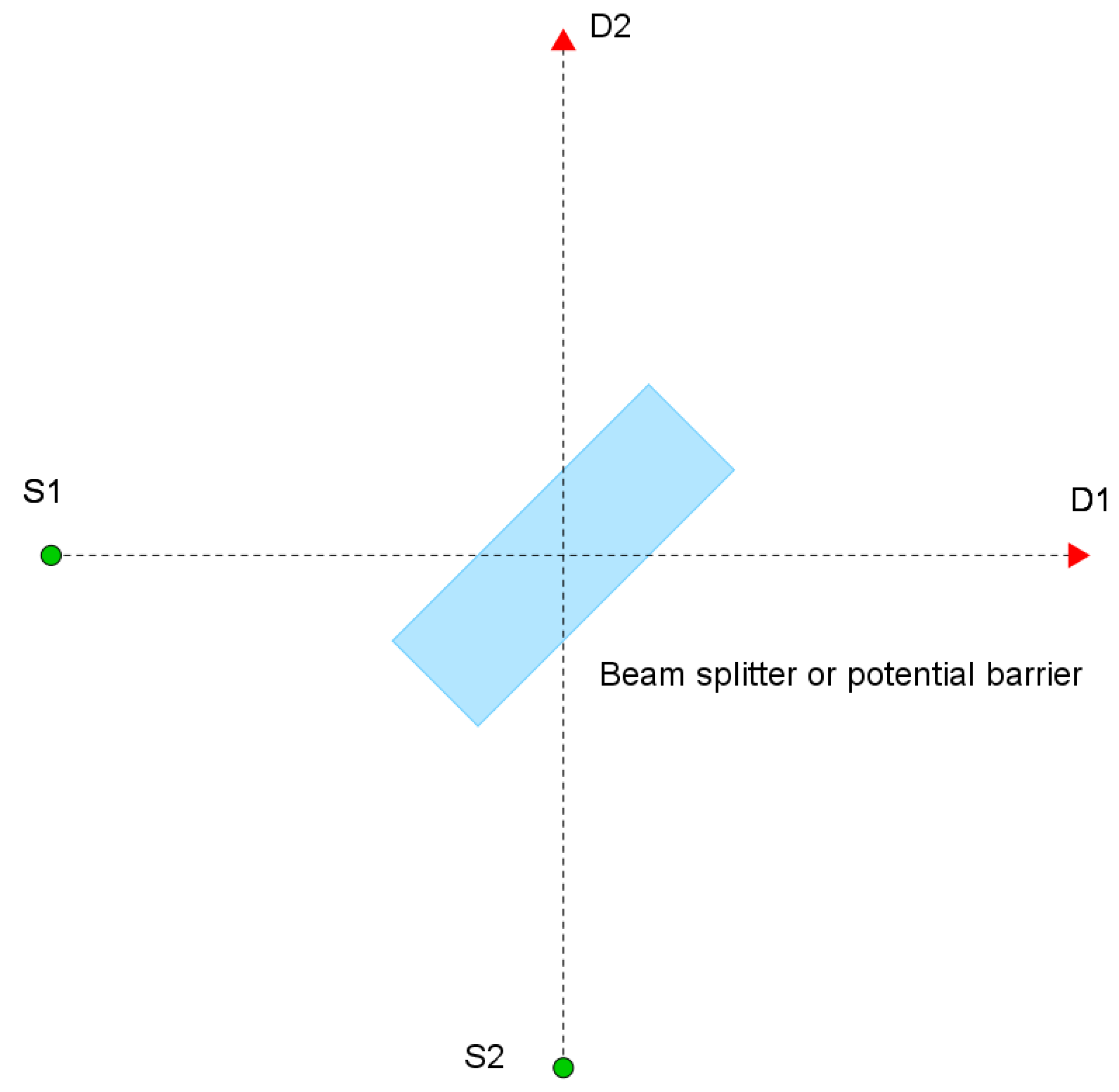Recent Progress on the Sum over Paths Approach in Quantum Mechanics Education
Abstract
:1. Introduction
- Is it possible that using the sum over paths approach may encourage students to retain the classical concept of trajectory, as they may misinterpret Feynman paths as trajectories that are taken alternatively according to some probability rule?
- The treatment of simple one-dimensional time independent systems may be much more complicated using Feynman’s approach than using a standard formulation (i.e., a wavefunction approach).
- Can the approach be integrated to provide at least an elementary introduction to concepts, related to spin?
2. A summary of Recent Developments
3. Time Dependent vs. Time Independent Sum over Paths Approach
- Considering an initial wavefunction (a “wavepacket”) and evolving all the points belonging to it using Feynman’s path integral propagator.
- Considering the time-independent problem (at fixed energy) of the propagation of a quantum object from the source to the detector, and using the time-independent propagator (Green function), which basically (apart from a prefactor) reduces to with x denoting the path length. This approach draws, in addition to Feynman’s original works, from more recent research in the area of semiclassical path integrals [22].
3.1. The Time-Dependent Sum over Paths Approach
- The quantum object goes through all possible paths from an initial space–time point (xi, ti) to a final space–time point (xf, tf).
- A complex number, often represented by a conventional rotating vector, is associated with each of the paths; its phase angle is proportional to the classical action, R = ∫(t)dt, calculated along the path. Here, denotes the Lagrangian.
- The (normalized) sum of all contributions from the possible paths starting at (xi, ti) and ending at (xf, tf) gives the time-dependent propagator, which can be understood as the probability amplitude of finding at (xf, tf) a quantum object that was initially at (xi, ti).
- The probability, P, of detecting the quantum object at (xf, tf) is then computed by taking the square modulus of the propagator.
- A time-dependent formulation may increase students’ confusion about the concepts of quantum paths and classical trajectories.
- The time-dependent treatment obscures the fact that many of the most important predictions of quantum physics are actually time-independent statistics. For example, finding the eigenfunctions for confining potentials usually requires computing the time-dependent propagator and then determining the initial amplitudes that, for the given propagator, are stationary in time, a procedure which appears intricated to students even in the presence of technological aids such as tailored simulation software.
3.2. The Time Independent Sum over Paths Approach
- The quantum object goes through all possible paths at fixed energy, E, from an initial point in space, xi (the source), to a final one, xf (the detector).
- A complex number, often represented by a conventional rotating vector, is associated with each of the paths; its phase angle is proportional to the classical abbreviated action, S = ∫p(x) dx, calculated along the path, where p(x) is the particle momentum at point x.
- The sum of all contributions from the possible paths at fixed energy starting at xi and ending at xf gives the energy-dependent propagator, or Green function, which can be understood as the probability amplitude of finding at xf, independently of arrival time, a particle with defined energy whose source is at xi.
- The probability P of detecting the quantum object at xf is then proportional to the square modulus of the Green function. For bound systems, the probability is nonvanishing only when the energy E corresponds to an allowed energy level.
- The action R is replaced by the abbreviated action S;
- All paths connecting xi and xf, regardless of travel time, are considered.
4. Treatment of Stationary Problems
4.1. Infinite Square Well
4.2. Tunneling from a Square Barrier
5. Stationary Sum over Paths Approach and the Time-Energy Uncertainty Relationship
6. Connections with Spin: From the Hong-Ou-Mandel Experiment to Quantum Computing
7. Path Indistinguishability and the Zhou–Wang–Mandel Experiment
8. Educational Outcomes
9. Discussion and Recapitulation of Educational Perspectives
- On the mathematical level, the sum over paths approach allows quantum phenomena to be discussed using quite a simple formal language. At its heart, such a possibility is due to the fact that, rather than finding solutions to the Schrödinger equation, Feynman’s method constructs the Green function for the same equation, representing it as a sum of complex amplitudes computed over all possible paths. In educational practice, complex amplitudes associated with paths can be represented and added up as vectors or “little arrows”, a strategy directly derived from the one used by Feynman himself, which greatly reduces the stress on student’s cognitive resources while learning the basics of quantum theory. The recent advances in the design of teaching–learning sequences based on sum over paths, mostly due to a significant clarification of the subject matter and the adoption of the time-independent version of the approach, allow the same simple mathematical machinery essentially to be treated with all problems, which are typically solved with the one-dimensional time-independent Schrodinger equation. Thus, sum over paths can be considered an attractive option not only for secondary education, but also for the introduction of elements of quantum physics to non-physicists.
- On the conceptual level, sum over paths has the unique peculiarity of offering students a clear and unambiguous representation of one of the most profound quantum mysteries, namely wave particle duality. There are two basic ingredients that contribute to forming such conceptual understanding. The first one consists of the distinction between classical and quantum ways of computing probabilities, which is at the heart of the approach, and allows what is always “corpuscular” in quantum objects’ behaviour (they are always revealed as discrete entities at detectors) and what may, or may not, be “wave-like” (the statistics of their detection events) to be clearly distinguished. The second ingredient is the focus on path distinguishability/indistinguishability, which allows a modern understanding of duality to be constructed in which an either/or (particle or wave) idea of the quantum object is replaced by a continuum of wave-like and particle-like behaviours, regulated by the respective weight of path distinguishability and fringe visibility. Furthermore, while going through this educational path, students generalize the concept of ‘sum over paths’ to ‘sum over histories’, and by doing so they construct a language capable to discuss modern experiments and technologies based on quantum optics, and in principle, to understand the conceptual meaning of simpler Feynman diagrams [15]. Finally, modern educational reconstructions based on sum over paths can offer deep insight into the origin of energy quantization for bound systems, and help clarify the meaning of the time-energy uncertainty principle.
- At the level of knowledge integration, the sum over paths formulation can make the classical limit (correspondence principle) completely transparent [8], and provide a unifying perspective on the nature of light, connecting ray optics, wave optics, and the quantum behaviour of photons. The approach allows students to build consistent mental models for photons and electrons, in which differences (the dispersion relation, the exchange rule) are highlighted that build on a common basic model of the quantum object. Rather than presenting quantum theory as a set of disconnected formulas for different situations, as it appears in many secondary school textbooks, in sum over paths the subject matter is presented as an organic theory, with the additional advantage of offering the possibility to teachers to develop their own exercises and problems, applying the computational rules to new situations.
10. Conclusions
Author Contributions
Funding
Data Availability Statement
Conflicts of Interest
References
- Feynman, R.P. Space-time approach to non-relativistic quantum mechanics. Rev. Mod. Phys. 1948, 20, 367–387. [Google Scholar] [CrossRef]
- Feynman, R.P. QED: The Strange Theory of Light and Matter; Princeton University Press: Princeton, NJ, USA, 1985. [Google Scholar]
- Taylor, E.F.; Vokos, S.; O’Meara, J.M.; Thornber, N.S. Teaching Feynman’s sum-over-paths quantum theory. Comput. Phys. 1998, 12, 190–199. [Google Scholar] [CrossRef]
- Ogborn, J.; Whitehouse, M. (Eds.) Advancing Physics AS; Institute of Physics Publishing: Bristol, UK, 2000. [Google Scholar]
- Dobson, K.; Lawrence, I.; Britton, P. The A to B of quantum physics. Phys. Educ. 2000, 35, 400–405. [Google Scholar] [CrossRef]
- Hanc, J.; Tuleja, S. The Feynman Quantum Mechanics with the help of Java applets and physlets in Slovakia. In Proceedings of the 10th Workshop on Multimedia in Physics Teaching and Learning (MPTL), Berlin, Germany, 5–7 October 2005; Available online: https://citeseerx.ist.psu.edu/viewdoc/download?doi=10.1.1.468.3374&rep=rep1&type=pdf (accessed on 15 August 2022).
- de los Angeles Fanaro, M.; Otero, M.R.; Arlego, M. Teaching basic quantum mechanics in secondary school using concepts of Feynman path integrals method. Phys. Teach. 2012, 50, 156–158. [Google Scholar] [CrossRef]
- Ogborn, J.; Taylor, E.F. Quantum physics explains Newton’s laws of motion. Phys. Educ. 2005, 40, 26–34. [Google Scholar] [CrossRef]
- Hanc, J. The time-independent Schrodinger equation in the frame of Feynman’s version of quantum mechanics. In Proceedings of the 11th Workshop on Multimedia in Physics Teaching and Learning, Szeged, Hungary, 20–22 September 2006; Available online: https://physedu.science.upjs.sk/modelovanie/files/hanc_szeged_2006.pdf (accessed on 15 August 2022).
- Stefanel, A. Impostazioni e percorsi per l’insegnamento della meccanica quantistica nella scuola secondaria. Giorn. Fis. 2008, 49, 15–53. [Google Scholar] [CrossRef]
- Malgieri, M. State of the Art of the Sum over Paths Approach in Education. In Proceedings of the 3rd World Congress on Physics Education: Innovating Physics: From Research to Practice (WCPE III 2021), Hanoi, Vietnam, 13–17 December 2021; Available online: https://indico.cern.ch/event/1025696/contributions/4630286/ (accessed on 15 August 2022).
- Malgieri, M.; Onorato, P.; De Ambrosis, A. A sum-over-paths approach to one-dimensional time-independent quantum systems. Am. J. Phys. 2016, 84, 678–689. [Google Scholar] [CrossRef]
- Malgieri, M.; Onorato, P. Educational reconstructions of quantum physics using the sum over paths approach with energy dependent propagators. J. Phys. Conf. Ser. 2021, 1929, 012047. [Google Scholar] [CrossRef]
- Malgieri, M.; Zuccarini, G.; Onorato, P. Approximate time–energy uncertainty relationship from the fixed-energy sum over paths approach. Canad. J. Phys. 2022. [Google Scholar] [CrossRef]
- Malgieri, M.; Tenni, A.; Onorato, P.; De Ambrosis, A. What Feynman could not yet use: The generalised Hong–Ou–Mandel experiment to improve the QED explanation of the Pauli exclusion principle. Phys. Educ. 2016, 51, 055002. [Google Scholar] [CrossRef]
- Malgieri, M.; Onorato, P.; De Ambrosis, A. Teaching quantum physics by the sum over paths approach and GeoGebra simulations. Eur. J. Phys. 2014, 35, 055024. [Google Scholar] [CrossRef]
- Malgieri, M.; Onorato, P.; De Ambrosis, A. GeoGebra simulations for Feynman’s sum over paths approach. Il Nuovo Cim. C 2018, 41, 124. [Google Scholar] [CrossRef]
- Malgieri, M.; Onorato, P.; De Ambrosis, A. Test on the effectiveness of the sum over paths approach in favoring the construction of an integrated knowledge of quantum physics in high school. Phys. Rev. Phys. Educ. Res. 2017, 13, 010101. [Google Scholar] [CrossRef]
- de los Angeles Fanaro, M.; Arlego, M.; Otero, M.R. A didactic proposed for teaching the concepts of electrons and light in secondary school using Feynman’s path sum method. Eur. J. Phys. Educ. 2017, 3, 1–11. Available online: http://www.eu-journal.org/index.php/EJPE/article/view/107 (accessed on 7 July 2022).
- Hochrainer, A.; Lahiri, M.; Erhard, M.; Krenn, M.; Zeilinger, A. Quantum indistinguishability by path identity and with undetected photons. Rev. Mod. Phys. 2022, 94, 025007. [Google Scholar] [CrossRef]
- Passon, O.; Zügge, T.; Grebe-Ellis, J.; Passon, O.; Zügge, T.; Grebe-Ellis, J. Pitfalls in the teaching of elementary particle physics. Phys. Educ. 2018, 54, 015014. [Google Scholar] [CrossRef]
- Blumel, R. Advanced Quantum Mechanics: The Classical-Quantum Connection; Jones & Bartlett Publishers: Sudbury, MA, USA, 2010. [Google Scholar]
- Sawant, R.; Samuel, J.; Sinha, A.; Sinha, S.; Sinha, U. Nonclassical paths in quantum interference experiments. Phys. Rev. Lett. 2014, 113, 120406. [Google Scholar] [CrossRef] [PubMed]
- Hanc, J.; Taylor, E.F. From conservation of energy to the principle of least action: A story line. Am. J. Phys. 2004, 72, 514–521. [Google Scholar] [CrossRef]
- de los Ángeles Fanaro, M.; Otero, M.R. Basics Quantum Mechanics teaching in secondary school: One conceptual structure based on Paths Integrals Method. Lat. Am. J. Phys. Educ. 2008, 2, 103–112. Available online: http://www.lajpe.org/may08/03_Maria_Fanaro.pdf (accessed on 7 July 2022).
- Cuppari, A.; Rinaudo, G.; Robutti, O.; Violino, P. Gradual introduction of some aspects of quantum mechanics in a high school curriculum. Phys. Educ. 1997, 32, 302–308. [Google Scholar] [CrossRef]
- Styer, D.F. The Strange World of Quantum Mechanics; Cambridge University Press.: Cambridge, UK, 2000. [Google Scholar] [CrossRef]
- McGinness, L.P.; Savage, C.M. Action physics. Am. J. Phys. 2016, 84, 704–708. [Google Scholar] [CrossRef] [Green Version]
- Gutzwiller, M.C. Phase-Integral Approximation in Momentum Space and the Bound States of an Atom. J. Math. Phys. 1967, 8, 1979–2000. [Google Scholar] [CrossRef]
- Schulman, L.S. Techniques and Applications of Path Integration; John Wiley and Sons: New York, NY, USA, 1981; Available online: https://vdoc.pub/documents/techniques-and-applications-of-path-integration-gn5q7aenmls0 (accessed on 7 July 2022).
- GeoGebra. Available online: https://www.geogebra.org/m/Q6waMV2v (accessed on 7 July 2022).
- Mastropaolo, G. ”Cammini di Feynman” in Laboratorio di G. Mastropaolo. Available online: https://mastropaolo.net/didattica-con-scratch/fisica/cammini-di-feynman (accessed on 7 July 2022).
- Solvang, L.; Haglund, J. How can GeoGebra support physics education in upper-secondary school—A review. Phys. Educ. 2021, 56, 055011. [Google Scholar] [CrossRef]
- Kleinert, H. Path Integrals in Quantum Mechanics, Statistics, Polymer Physics, and Financial Markets; World Scientific: Singapore, 2009. [Google Scholar] [CrossRef]
- Peak, D.; Inomata, A. Summation over Feynman histories in polar coordinates. J. Math. Phys. 1969, 10, 1422–1428. [Google Scholar] [CrossRef]
- Duru, I.H.; Kleinert, H. Quantum Mechanics of H-Atom from Path Integrals. Fortschr. Phys. 1982, 30, 401–435. [Google Scholar] [CrossRef]
- Gamow, G. The quantum theory of nuclear disintegration. Nature 1928, 122, 805. [Google Scholar] [CrossRef]
- Holstein, B.R. Understanding alpha decay. Am. J. Phys. 1996, 64, 1061–1071. [Google Scholar] [CrossRef]
- Hong, C.K.; Ou, Z.Y.; Mandel, L. Measurement of subpicosecond time intervals between two photons by interference. Phys. Rev. Lett. 1987, 59, 2044–2046. [Google Scholar] [CrossRef]
- Lim, Y.L.; Beige, A. Generalized Hong–Ou–Mandel experiments with bosons and fermions. New J. Phys. 2005, 7, 155. [Google Scholar] [CrossRef]
- Maries, A.; Sayer, R.; Singh, C. Can students apply the concept of “which-path” information learned in the context of Mach–Zehnder interferometer to the double-slit experiment? Am. J. Phys. 2020, 88, 542–550. [Google Scholar] [CrossRef]
- Sutrini, C.; Malgieri, M.; Macchiavello, C. Quantum technologies: A course for teacher professional development. J. Phys. Conf. Ser. 2022, 2297, 012018. [Google Scholar] [CrossRef]
- Zhou, X.Y.; Wang, L.J.; Mandel, L. Induced coherence and indistinguishability in optical interference. Phys. Rev. Lett. 1991, 67, 318–321. [Google Scholar] [CrossRef] [PubMed]
- Englert, B.G. Fringe visibility and which-way information: An inequality. Phys. Rev. Lett. 1996, 77, 2154–2157. [Google Scholar] [CrossRef] [PubMed]
- Linn, M.C. Designing the knowledge integration environment. Int. J. Sci. Educ. 2000, 22, 781–796. [Google Scholar] [CrossRef]
- Fanaro, M.; Otero, M.; Elgue, M. Implementation of a proposal to teach quantum mechanics concepts from the Multiple Paths of Feynman applied to the light. In Proceedings of the GIREP-MPTL International Conference on Teaching/Learning Physics: Integrating Research into Practice, Palermo, Italy, 7–12 July 2014; pp. 225–232. Available online: https://www.researchgate.net/profile/Maria-Otero-6/publication/262186885_Implementation_of_a_proposal_to_teach_quantum_mechanics_concepts_from_the_Multiple_Paths_of_Feynman_applied_to_the_light/links/55c7dd6208aeca747d667def/Implementation-of-a-proposal-to-teach-quantum-mechanics-concepts-from-the-Multiple-Paths-of-Feynman-applied-to-the-light.pdf (accessed on 7 July 2022).
- Sutrini, C.; Malgieri, M.; De Ambrosis, A. Bubble: Experimenting with Feynman’s sum over paths approach in the secondary school. Il Nuovo Cim. C 2019, 42, 1–10. [Google Scholar] [CrossRef]






Publisher’s Note: MDPI stays neutral with regard to jurisdictional claims in published maps and institutional affiliations. |
© 2022 by the authors. Licensee MDPI, Basel, Switzerland. This article is an open access article distributed under the terms and conditions of the Creative Commons Attribution (CC BY) license (https://creativecommons.org/licenses/by/4.0/).
Share and Cite
Malgieri, M.; Onorato, P. Recent Progress on the Sum over Paths Approach in Quantum Mechanics Education. Physics 2022, 4, 1012-1025. https://doi.org/10.3390/physics4030067
Malgieri M, Onorato P. Recent Progress on the Sum over Paths Approach in Quantum Mechanics Education. Physics. 2022; 4(3):1012-1025. https://doi.org/10.3390/physics4030067
Chicago/Turabian StyleMalgieri, Massimiliano, and Pasquale Onorato. 2022. "Recent Progress on the Sum over Paths Approach in Quantum Mechanics Education" Physics 4, no. 3: 1012-1025. https://doi.org/10.3390/physics4030067




